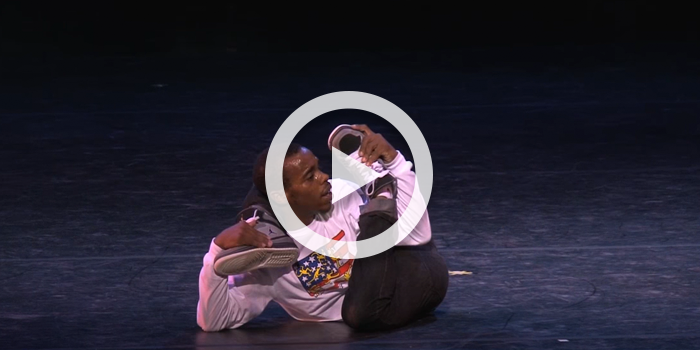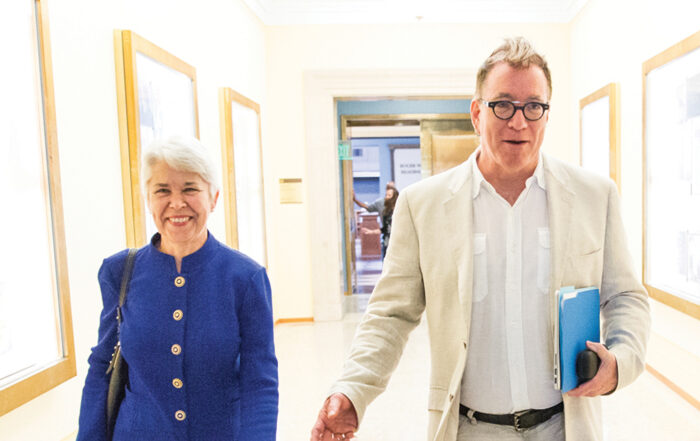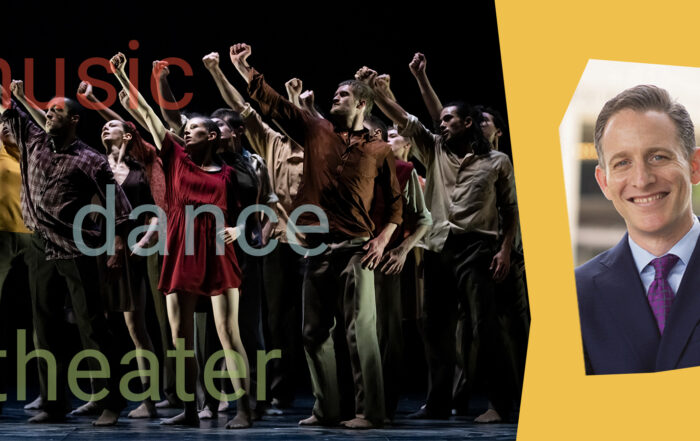In this issue: Violinist Kyung-Wha Chung performs Bruch’s Violin Concerto No. 1 in G minor, Op. 26; Mezzo-soprano Grace Bumbry performs Bizet’s Seguedille from Carmen; Pianists Martha Argerich and Evgeny Kissin perform Lutosławski’s Variations on a Theme by Paganini; Diana Adams and Arthur Mitchell perform George Balanchine’s pas des deux from Agon; the Orchestre de Paris performs Revueltas’s “Noche de encantamiento” from La noche de los mayas
Now, More Than Ever: Issue 20
Bruch: Violin Concerto No. 1 in G minor, Op. 26
Kyung-Wha Chung, violin
André Previn, conductor
London Symphony Orchestra
In the years following World War II, Korea began to place an enormous amount of importance on the teaching of Western classical music, ultimately sending large numbers of gifted music students out into the world to pursue serious careers. Chief among them was Kyung-Wha Chung, the first superstar female Asian violinist, a true trailblazer and an artist who paved the way for so many others. Today she continues her work as a teacher at Juilliard (where, as a student, she was affectionately known as “Cookie”!).
Chung has a deep connection with Bruch’s G minor Violin Concerto, one of the first works in the genre that most violinists learn. For me, it is a true “guilty pleasure” piece, but as is the case with so many “war horses,” it’s popular for a reason. Hyper-romantic and full of over-the-top emotiveness and virtuoso display, it always brings me joy. This spirited performance from the mid-1970s, featuring conductor André Previn and the London Symphony Orchestra, finds Chung at her youthful—and impressive—best.
(Spare a few minutes, if you can, for a short interview from around the same time, between Chung and the British journalist Humphrey Burton. It’s a bit uncomfortable—the questions are more than a little sexist and patronizing—but Chung’s winning personality shines through and it’s easy to see why she was so beloved and why it meant so much to South Koreans to have an artist of this stature representing them at the highest levels of culture.)
Bizet: Seguedille from Carmen
Grace Bumbry, mezzo-soprano
Jon Vickers, tenor
Herbert von Karajan, conductor
Vienna Philharmonic Orchestra
Yes, Grace Bumbry is unbelievably seductive here as Bizet’s fiery, provocative, untamable cigarette girl, but she’s also equally persuasive and commanding as a singer and actress. I count her as one of the greatest vocalists of the 20th (actually, into the 21st) century, the first black performer to appear at Bayreuth, that legendary temple of Wagnerian nationalism and xenophobia, where her mere presence was enough to raise German hackles and cause a memorable stir. More recent triumphs include her selection among President Obama’s recipients of the 2009 Kennedy Center Honors for her lifetime of contributions to the performing arts.
This particular video is the product of a pet project of conductor Herbert von Karajan, who wanted to make film versions of operas—actual films of the drama, rather than staged performances—that he planned to direct himself. Here, his choice of Bumbry in the title role surprised more than a few at the Vienna Philharmonic, but she soon quieted the naysayers with a performance as enchanting as it was vocally assured.
Lutosławski: Variations on a Theme by Paganini
Martha Argerich and Evgeny Kissin, pianos
I’m surprised that it has taken some 20 issues of Now, More Than Ever before we have encountered a performance by the fireball of talent, the true force of nature that is Martha Argerich. Hailing from a Russian-Jewish family that settled in Argentina, Argerich grew up there, a neighbor and friend since childhood of conductor/pianist Daniel Barenboim. Her father then received a diplomatic posting to Vienna, where the young Martha continued her piano studies. In 1957, at the age of 16, she won both the Geneva International Music Competition and the Ferruccio Busoni International Competition within three weeks of each other. Argerich rose to international prominence when, at the age of 24, she won the 1965 International Chopin Piano Competition in Warsaw; that same year, she made her US debut on Lincoln Center’s Great Performers Series.
I’m always struck by the quality of physical instinctiveness in Argerich’s performances; there’s no question of right or wrong here, rather one senses an almost animal instinct at play—but also a force that is deeply refined. Here she is absolutely devouring Witold Lutosławski’s Variations on a Theme by Paganini—and radiating absolute joy as she does so. (The Verbier Festival is one of those star-attracting endeavors where powerhouse pairings like this are almost every-day occurrences. Evgeny Kissin is himself a world-class talent, an artist of true subtlety and skill, but even here, you sense him upping his game to match Argerich’s volcanic efforts at the keyboard. What an incredible showpiece!)
On a personal level, Lutosławski is my favorite composer of the 20th century. His works always keep the listening ear in mind and are full of impish twists and ravishing beauty. This piece was written during World War II, during the German occupation of Warsaw, when Lutosławski had formed a piano duo with his friend and fellow composer Andrzej Panufnik. Together, they performed in cafés throughout the city, the only way in which Poles could legitimately hear live music (organized gatherings and concerts being banned). This was one of their most popular pieces—they brought down the house every time they played it.
Pas de deux from Agon
George Balanchine, choreographer
Diana Adams and Arthur Mitchell, dancers
New York City Ballet
The only thing that isn’t wonderful about this performance is how absolutely terribly the orchestra plays the music; you can feel them still trying to wrap their minds around Stravinsky’s relatively recent and thorny score. Arguably the most important composer for dance during the 20th century, Stravinsky wrote only four scores for ballets by George Balanchine (though the two men enjoyed a long and fruitful creative partnership). As the New York Times wrote, describing a New York City Ballet tribute to that relationship, “Agon occupies a central position in Balanchine’s oeuvre, a ground-shifting masterpiece in which he and Stravinsky drew from mid-17th-century court dances to create what Balanchine called a ‘quintessential contemporary ballet’ that represented a total collaboration with the composer. Harshly astringent at times, sportily athletic at others, the tightly knit Agon includes one of the most eerily intense and sensuous of pas de deux….”
Balanchine created this timeless choreography specifically for Arthur Mitchell (the first African-American dancer at the New York City Ballet) and the white southern ballerina Diana Adams (he was making a point) and I love how the fluidity of this movement sits in contrast to the music itself; it is simply ravishing to watch. Mitchell would take his skills to the next stages of his career, which included Broadway shows and the founding of various dance companies, and ultimately the creation, in 1969, of the legendary Dance Theatre of Harlem, which became his life’s work and greatest legacy. Many in the Cal Performances audience will fondly recall Mitchell’s presence during company residencies at Zellerbach Hall, especially during his charismatic work with young people. To me, it’s truly inspiring when someone has the world at their feet and then chooses to return home again. Arthur Mitchell changed lives.
Revueltas: “Noche de encantamiento” from La noche de los mayas
Kristjan Järvi, conductor
Orchestre de Paris
Silvestre Revueltas originally wrote La noche de los Mayas for a 1939 film concerning the cultural clash between a tribe of Mayans and the modern world. As with Stravinsky’s revolutionary The Rite of Spring, this is evocative, ritualistic music that evokes a mystical lost world, and it ends with a wild sacrificial dance calling for an absolutely huge number of percussionists. Later adapted as a concert suite for symphony orchestra by José Ives Limantour (the version you are hearing in this performance), it is one of Mexico’s cultural treasures.
There may be better musical performances out there, but I love this video because it gives you a terrific view of the 14 percussionists (including conch shell!), as Revueltas engages his succession of incredible musical machines, each instrument of the percussion section receiving its own virtuosic cadenza. It keeps going, and going, and going, ratcheting up the tension and musical suspense, finally exploding in a cascade of sound intended to shake the foundations of the world. (Watching this, it’s easy to see why one of the great risks to orchestral musicians can be permanent hearing loss!)
Now, More Than Ever Full Playlist
Now, More Than Ever Spotify Playlist








